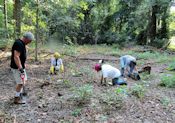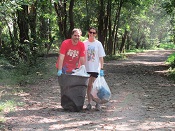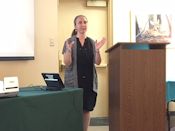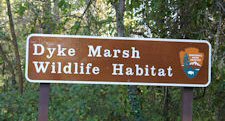On October 4, 2018, ten dedicated FODM volunteers and National Park Service staffers put in another 400 or so plants in our native plant demonstration area along the west side of the Haul Road trail, bringing our total plantings this year to around 3,500. Despite the oppressive heat and a “healthy population” of mosquitoes, “It was a true labor of love,” said Ned Stone, FODM Vice President.
The Friends of Dyke Marsh and the National Park Service hosted 35 volunteers, ages five to unknown, who collected 50 big bags of trash for three hours along the Potomac River and Dyke Marsh shoreline during low tide on September 22.
Dr. Desiree Narango, an ecologist, gave a presentation to 70 people on September 12, 2018, explaining how native and non-native plants affect breeding bird populations, behavior and food web interactions. She worked with the Smithsonian Institution's Neighborhood Nestwatch program which focuses on breeding birds in urban/suburban backyards. Like most songbirds, Carolina chickadees are very dependent on caterpillars and other insects when raising their young. A chickadee with four to seven young, needs between 390 to 570 caterpillars every day to feed their young. Caterpillars are very dependent on certain host plants.
Crews operating barges, cranes and boats are at work this fall, 2018, building the breakwater in the Dyke Marsh Wildlife Preserve, the first stage of Dyke Marsh restoration. The U.S. Geological Survey’s 2010 and 2013 studies identified building a breakwater as the first priority of restoration, a riprap structure designed to replicate the historic promontory removed by dredgers.
The Mount Vernon Gazette (Connection newspapers) published a front-page article on August 16, 2018, by Jerry Fill on the start of the restoration of Dyke Marsh. You can read the entire article online here.






